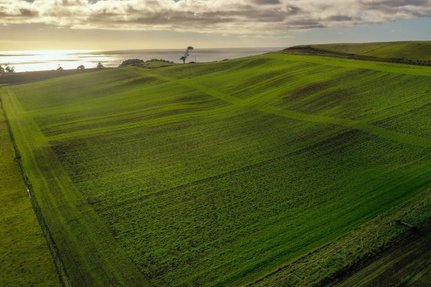Improve your productivity with better soil

Barenbrug’s Green Manure blend for cover crops in the fallow months.
The rugged northern coastline and the rolling hills of inland Tasmania are home to some of the most productive soils in the state. The rich red ferrosol soil indicative of a volcanic past produces a staggering volume of potatoes, carrots, onions as well botanical extracts such as poppies and pyrethrum, largely for export markets.
However, there has been a price to pay.
Hillslope erosion of those rolling hills has been an ongoing problem for many years and seen by many as an unfortunate outcome.
More often than not the solution has been to add more fertilisers to make up the shortfall of nutrients lost through erosion.
Vegetable crops in the region are usually harvested January to February and replanted in September. The autumn and winter months see the paddocks fallow in what is the wettest part of the year. Consequently, the ‘bare’ paddocks are exposed to significant rain events creating runoff plumes that can be visibly seen in Bass Strait to the north.
The use of cover crops is not a new idea but has been recognised as a way of minimising hillslope erosion by the Cradle Coast Authority NRM. Under a federally funded program, an initial trial began in 2019 to work with local producers to use a cover crop during the fallow months.
“The initial trial was on a 10 hectare site with a poor soil structure score of around 3 or 4,” says Ali Dugand, Protecting our Productive Soils (POPS) project coordinator, Cradle Coast Authority.
“The cover crop was a mix of legumes, cereals and broadleaf varieties which give a diverse range of nutrients, fix nitrogen and improve the overall soil health, while reducing the risk of erosion through runoff and rain splash.
“We worked with the farmer and the harvest contractors, as well as performing rigorous monitoring during the six months growing period. What we found was encouraging. The soil structure score went to around 7, and the improvement in soil health was noticeable. It was clear that soil compaction had reduced, the root depth went down to 15-20cm and for the first time there was no runoff into the dam that year. The contractors also commented that the soil structure supporting the subsequent crop of vegetables had also improved.”
The cover crop blend chosen by Ali and her team, was Barenbrug’s Green Manure Blend. Ideal for the slightly acidic soils of the central coast region, its often used by gardeners and fresh-market producers, but has been taken to a much greater level for the hillslope erosion program.
The combination of cereals and legumes such as, lupins, Tic beans and peas draws down and fixes nitrogen; generates biomass and captures nutrients that may otherwise leach with the erosion.
On the back of the success of the first season trial, a further three sites have been planted with the Green Manure blend, with a sowing rate of around 50kg/ha. The cover crop is planted around Easter while the ground is still relatively warm meaning that the crop jumps away quickly. In late July, the crop is given a herbicide knock down and allowed to die back prior to the September vegetable planting.
“Across the 19 paddocks that we have planted with the Green Manure blend, only two had poorer results, but even then had far better outcomes than they otherwise might have” says Ali.
“We have learned a lot with this program, but it is clearly evident to us and the farmers, that a cover crop in the fallow months is a worthwhile proposition for hillslope erosion and the increased productivity and lowered cost of production that can be achieved.”
Barenbrug’s Tasmanian based Rob Winter created the Green Manure mix in the early 2000’s to satisfy demand from garden centres and some soil-health conscious vegetable growers.
“We had a number of retail outlets with a steady stream of enquires for vigorous winter cereals and grain legumes to plant after vegetables had been harvested. The mix I settled upon includes three different cereals: rye, barley and oats, and three fast establishing legumes: lupins, faba (tic) beans and field peas. The species are proportioned to allow for seed sizes and balanced plant growth habit.”
“The cereals are particularly good for quick top-soil stabilisation with a very high number of fine fibrous, adventitious roots. The beans, lupins and peas further contribute with a deeper rooting system which accesses nutrients at depth returning them to the top-soil layer, and they have the capacity to fix atmospheric nitrogen for subsequent cropping.
“When the crop is still fairly young and lush at around 30-50cm high, the organic matter from the terminated crop is readily returned to the soil to improve many attributes including soil water holding capacity, nutrients and soil aggregate stability.”
Keen to improve your productivity with better soil? Contact your local Territory Manager to find the right Barenbrug Green Manure blend for your situation.
Below: Green manure cover crops contain cereals and legumes to provide a balance in plant size and growth to give soil stabilisation and nutrients.


